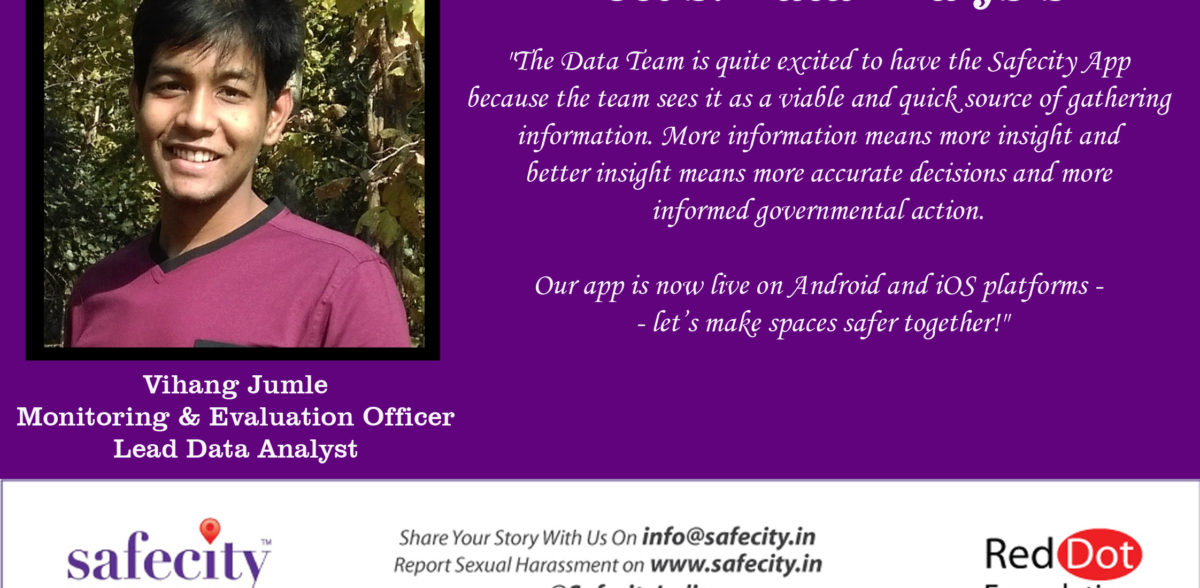Know Our Work: Crowdsourced Data for Change

Crowdsourced Data for Change
by Vihang Jumle
Curated by Vandita Morarka
You’ve gotten to know our team, we’re bringing you this series so that you can get to know our work better too. We explore the different verticals of our work through the lens of the people leading them.
The Safecity Data team is an integral part of the organization. Safecity uses crowdsourced data about sexual violence in public spaces towards informing action. We have a dedicated team which maintains and interprets data that is collected over time. The team also exists to meet the organization’s philosophy of using technology for social good. The Data Team has reached its two year mark and is gaining momentum in terms of delivering results and generating opportunities for all who find their passion in studying data. The Data team has expanded its boundaries from analysing just crowdsourced data from the website to analysing any data available readily or after mining that deals with women safety, social development and internal assessment.
What do we do in Analytics:
The Analytics program can be broken down into two components: Training Modules and Projects, both of which are merged into Project based training for better functioning of the team and producing results at a considerably fast pace. The analytics team undertakes numerous projects throughout the year and each volunteer in the team is assigned one of these projects based on a volunteer’s time commitment and skillset or expertise.
At Safecity, we train volunteers and analyse data to create content which we believe helps everyone make better informed decisions regarding their safety and develop analytical individuals who understand the importance of privacy, consent, and gender based violence and related issues.
How we do it:
The Data team comprises of individuals from different age groups and diverse expertise. This diversity is an asset to the team as this gives us the flexibility to experiment with different methodologies. Like the standard approach of Analytics, the team is capable of Collecting, Cleaning & Visualizing, Understanding and Interpreting Data. Depending on the depth of a project a volunteer might deal with all the four aspects or may deal with few that they find interesting. Collection of data is done via crowdsourcing, manual extraction, or viable collaborations with organizations willing to share information. The data is visualized using Excel or open-source software like R or even a higher end Integrated Development Environment coded in Python or Java. The Understanding and Interpreting is built on the visualized data. The process of visualization reveals the Key Performance Indicators which remain the main focus of Interpreting information. Machine Learning Algorithms are used to build predictive models specifically designed to meet the objectives. The other approach to interpreting data could be via comparative studies or descriptive studies depending on what the set objectives are. The team in parallel to undertaking social projects deals with data generated by Safecity from the website or Social media handles to understand and scale user interaction which helps the management to see growth and its effective outreach at any moment in time.
At Safecity, we produce results by harnessing different approaches to problems derived from experienced professionals from the industry or budding University students eager to step into Data Analytics. These approaches, outlooks and perspectives are compiled into easy-to-understand reports, including the Police Dashboards, Facebook Statistics, Social Sentimental Analysis, Crime Rate Correlations, etc. These documents are then circulated among external stakeholders like police authorities and internal stakeholders like the Policy and Legal Team, the Blogging team at Safecity where these are used as reference points.
Has this data been of help?
Safecity Police Dashboard is a spreadsheet that documents the crowdsourced information on public violence. This Dashboard is updated monthly and is sent to Police Authorities at different locations in India. We believe this information is then used by the authorities to investigate dominant crime spots and schedule patrolling in a way to minimize further cases of public violence.
Another project on lines of Crime Rate Visualization was used as reference by the Blogging team at Safecity to create content for the website for mass awareness of Crime rates in India.
Working with the Safecity App
The Data Team is quite excited to have the Safecity App because the team sees it as a viable and quick source of gathering information. More information means more insight and better insight means more accurate decisions and more informed governmental action. Volunteers of the Data team have actively been a part of the App development team.
I joined Safecity just like any other volunteer to contribute to society and to engage in Data Analytics. I had no prior experience in this area hence I joined the training program initially. The 3 months that followed included a rigorous pattern of study and skill development. Although I worked remotely I never felt disengaged as my mentor always took out time to drive me on the right path. And that is what I believe makes Safecity’s culture unique. We all play a role in helping each other out irrespective of what schedules we follow or where we are located. Not alone but we all progress together and that is tremendous. I think not just the intellectual skills but Safecity has made me a better communicator which is definitely a valuable possession. A platform, mentors, friends, importantly a vision for my career. We’re excited to see where, how far and how wide this app travels sending us information from distant corners of this globe. More Data, More Safety.
Connect with us?
Write in to [email protected] with feedback and queries. You can now download our app on Android and iOS systems – let’s make spaces safer together!


